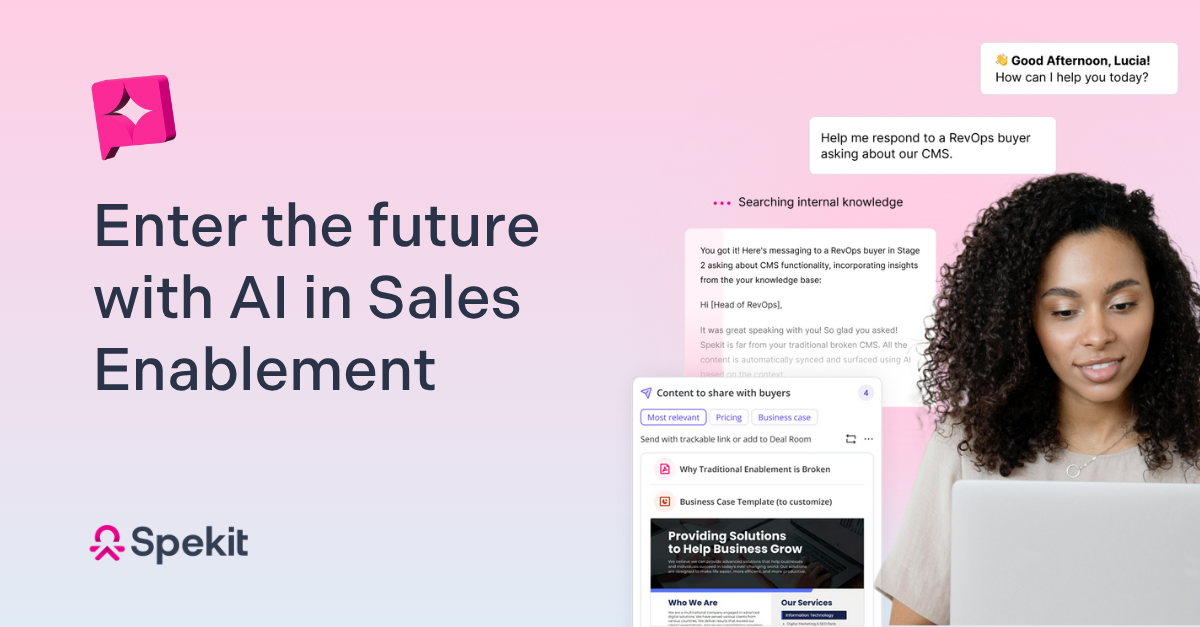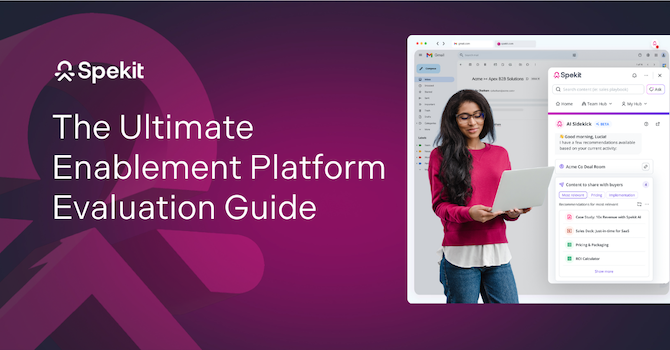Take a peek at your sales team's screens right now. How many tabs do they have open? Ten? Twenty?
Every one of them is a detour. Reps are constantly bouncing between tools, digging through decks, Slack threads, and call recordings, just to prep for a single conversation.
No wonder reps spend less than 30% of their time actually selling.
Even worse? When they finally find the collateral they need, there's no guarantee it's current, complete, or even correct.
Traditional sales enablement tools try to fix this by adding yet another dashboard...one more place to check, update, and eventually ignore.
AI sales enablement platforms change this approach entirely: instead of adding to the pile, they insert knowledge directly into the rep’s flow of work.
Spekit CEO and Founder Melanie Fellay describes it as surfacing the “exact right content at the right time in the employees’ workflow.”
Let’s break that down.
The big shift: Introducing AI into sales enablement connects reps to the right content at the right time
The real power of AI in sales enablement is delivering the right content, at the right time.
Traditional enablement puts the burden on reps to go find the info they need. AI flips that. Instead of pulling information, reps get it pushed to them. In the moment they need it, inside the tools they’re already using.
That shift, from pull to push, from memory to moment, is what actually drives results.
But timing alone isn’t enough; a generic call script sent after every discovery call qualifies as good timing after all.
The real differentiator is context.
AI in sales enablement doesn’t just guess. It learns what reps are working on, what’s worked in the past, and when they’re likely to need help. It then delivers content that’s not only timely, but relevant, personalized, and instantly actionable.
A battle card that surfaces mid-call when a lead mentions a competitor? That's perfect timing + strong context.
Together, timing and context transform enablement from a static library into a dynamic advantage.
And this shift isn’t a future state, it’s already here. According to the Sales Enablement Landscape Report, 80% of sales enablement teams already use AI at least occasionally in their daily work. And 25% rely on it regularly.
AI in enablement is how modern enablement teams stay ahead today.
6 use cases for AI in sales enablement (here's how AI solves common sales enablement headaches)
AI can’t close deals for your reps. But AI sales enablement platforms can solve the blockers that stop deals from closing.
1. AI keeps content clean, current, and conflict-free
Content decay shows up in small but costly ways. A rep sends a case study to a prospect, only to realize later it includes a sunsetted feature.
Another shares a pricing slide during a call, but it’s two versions old, and the numbers no longer reflect current offers. Someone drops a Google Doc into Slack to help a teammate prep, but it turns out to be version 7 of 11, and half the info is outdated.
These daily speed bumps erode rep confidence, waste buyer attention, and slow down deals.
It's no surprise that a whopping 86% of teams believe that their reps use less than 60% of their content.
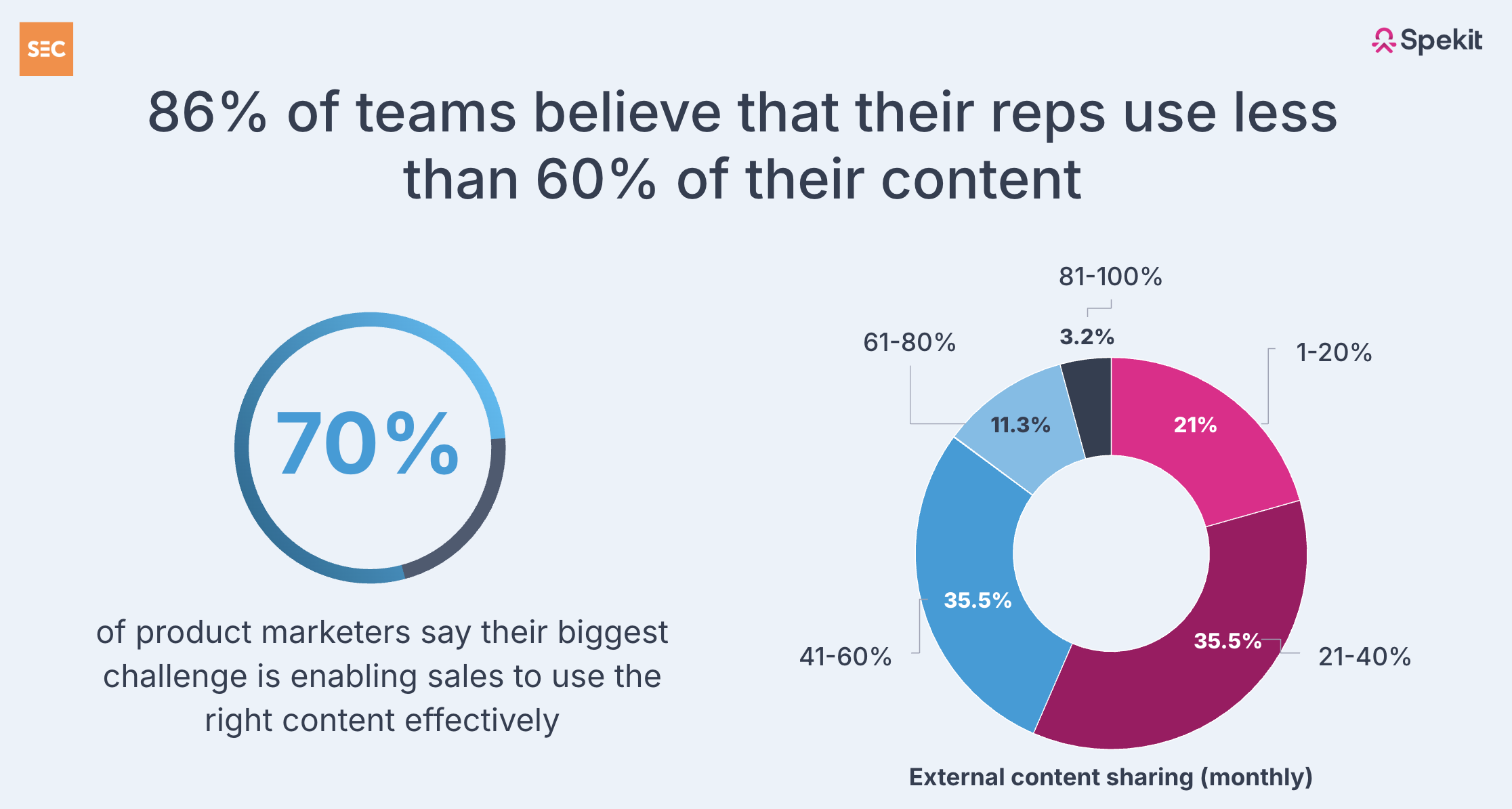
When used effectively, AI steps in as a content quality control system:
- It spots duplicate or contradictory content in your CMS
- Flags anything that’s out of sync with your CRM or product updates
- Proactively recommends the best version of what’s already working
Here’s how Spekit’s Intelligent Content Management, powered by AI Sidekick, keeps your content automatically organized, governed, and ready to deliver, surfacing verified, up-to-date resources directly in the flow of work.
1. Sync everything in one place.
First, Spekit connects to the content sources your team already uses, such as Google Drive, SharePoint, and Confluence. It pulls in everything from PDFs and Docs to training materials and battle cards.
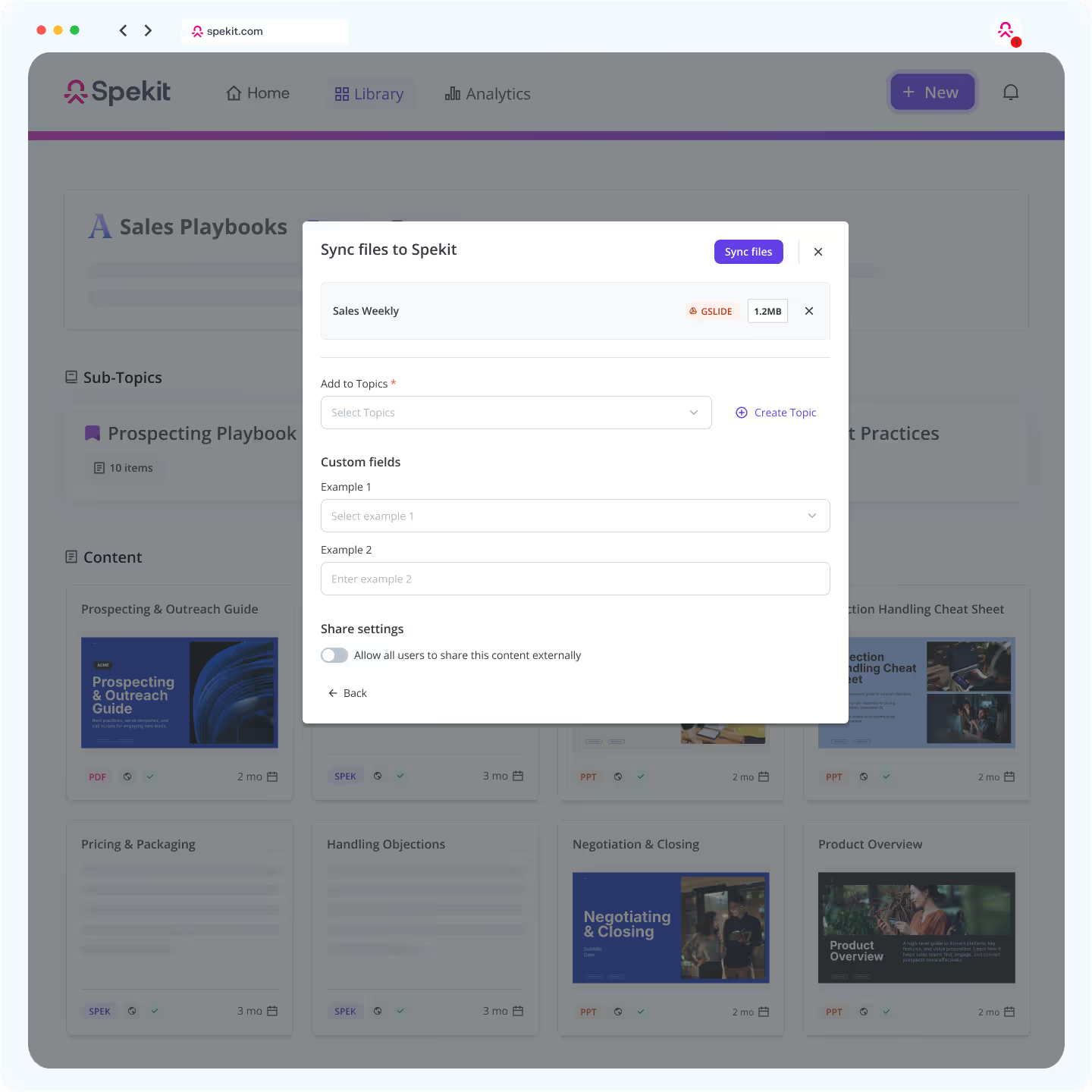
2. AI-powered deduplication flags conflicting or outdated content.
As soon as content is pulled in, Spekit’s AI kicks in. It scans for duplicates, conflicting information, or stale versions that might confuse your reps.
You’ll get a notification when something needs review, before it causes problems in the field.
3. Automated content governance runs in the background.
You don’t have to micromanage every doc or keep a manual spreadsheet of updates.
Spekit monitors your content continuously and helps you set rules for version control, visibility, and expiration, so nothing gets shared past its prime.
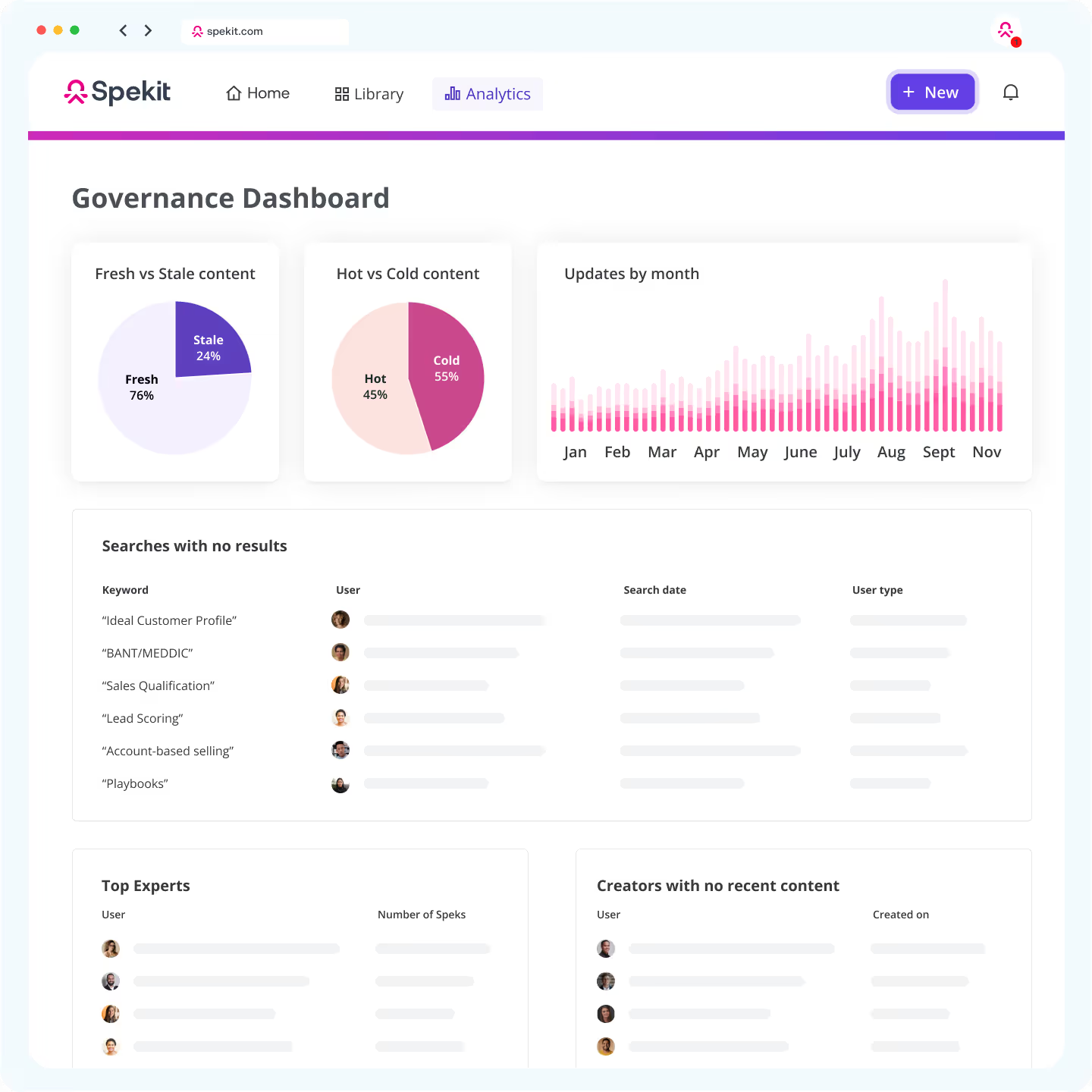
Clean content doesn’t sit in a folder. It shows up where it’s needed, like Salesforce, Gmail, or Slack, automatically.
So even if a rep never visits the content library, they’re still getting the latest, most accurate information.
2. AI turns onboarding into real-time reinforcement
A new hire gets a two-week crash course, then spends the next three months pinging their manager for links they vaguely remember from training.
They forget where the demo checklist lives. They miss a key step in discovery. And nobody catches it until a deal falls apart.
AI sales enablement platforms turn onboarding into everboarding, replacing static training with dynamic, real-time reinforcement.
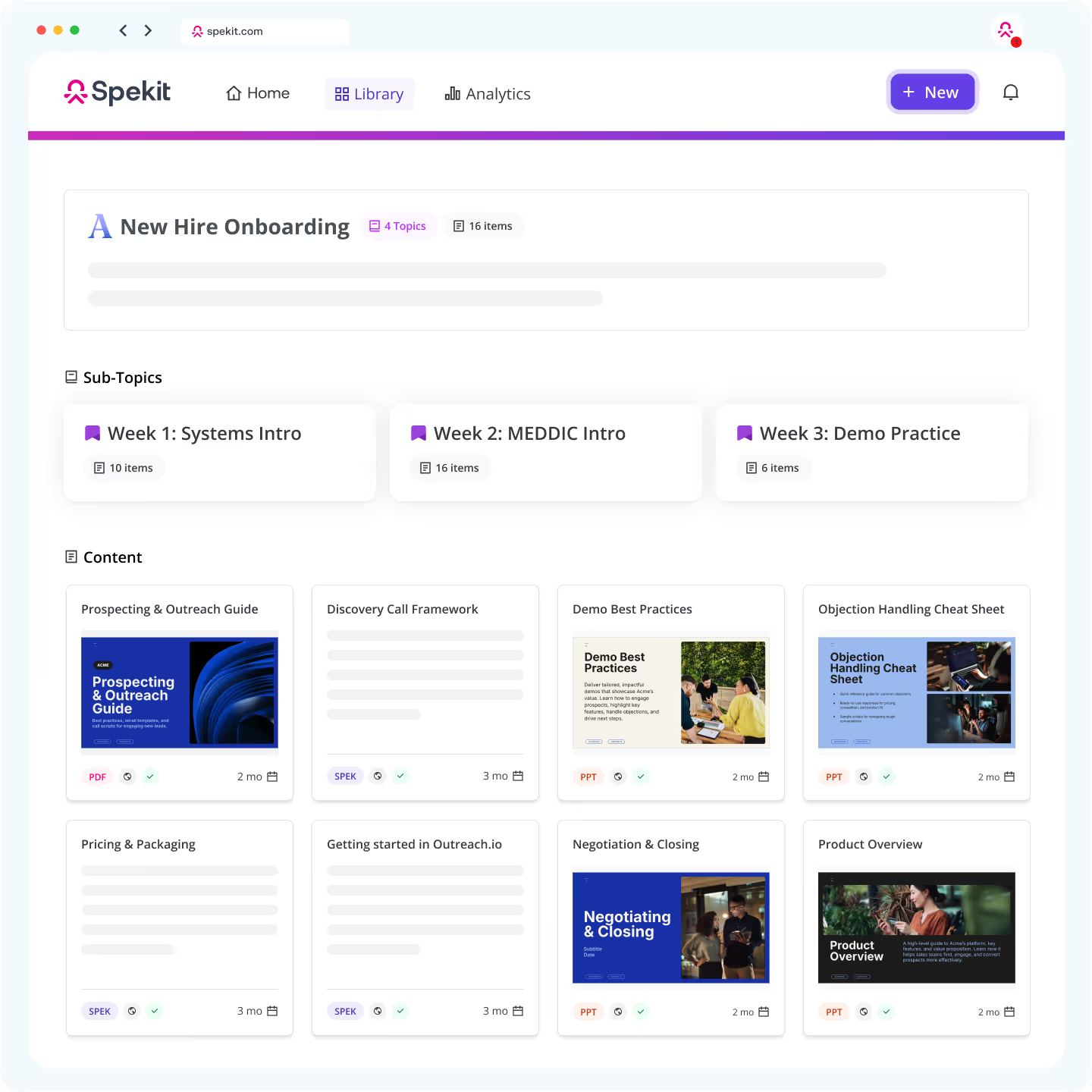
For example, Spekit enables you with:
- Building modular playlists that grow with your reps: Build onboarding tracks by role, product, or deal stage. Reps can work through bite-sized lessons at their own pace, with visible progress tracking and the ability to update content anytime, without rebuilding.
- In-the-moment training nudges: For example, when a rep opens Salesforce for the first time, Spekit automatically serves up onboarding guidance specific to that field or object.
- Contextual reinforcement at key stages: Move a deal to the demo stage? Spekit delivers best practices for discovery calls, talk tracks, and qualification checklists, right inside the tools reps are using.
3. AI enforces consistency across teams and talk tracks
Sales leader A calls a deal “qualified” after a cold call.
Sales leader B waits until there’s a mutual action plan.
One team leads with a new feature. Another forgets it exists.
This kind of inconsistency breaks forecasts, confuses buyers, and makes scaling a mess.
AI fixes this by standardizing how your processes are communicated and making sure everyone sees the same message, in the same way, at the same time.
For example, with Spekit, you'll see:
1. Modular content blocks (Speks): Every definition, checklist, or playbook lives in a Spek, a modular, searchable unit of knowledge. AI Sidekick then automatically surfaces the right Spek or Deal Room based on what reps are doing, keeping definitions, frameworks, and messaging aligned everywhere they work.
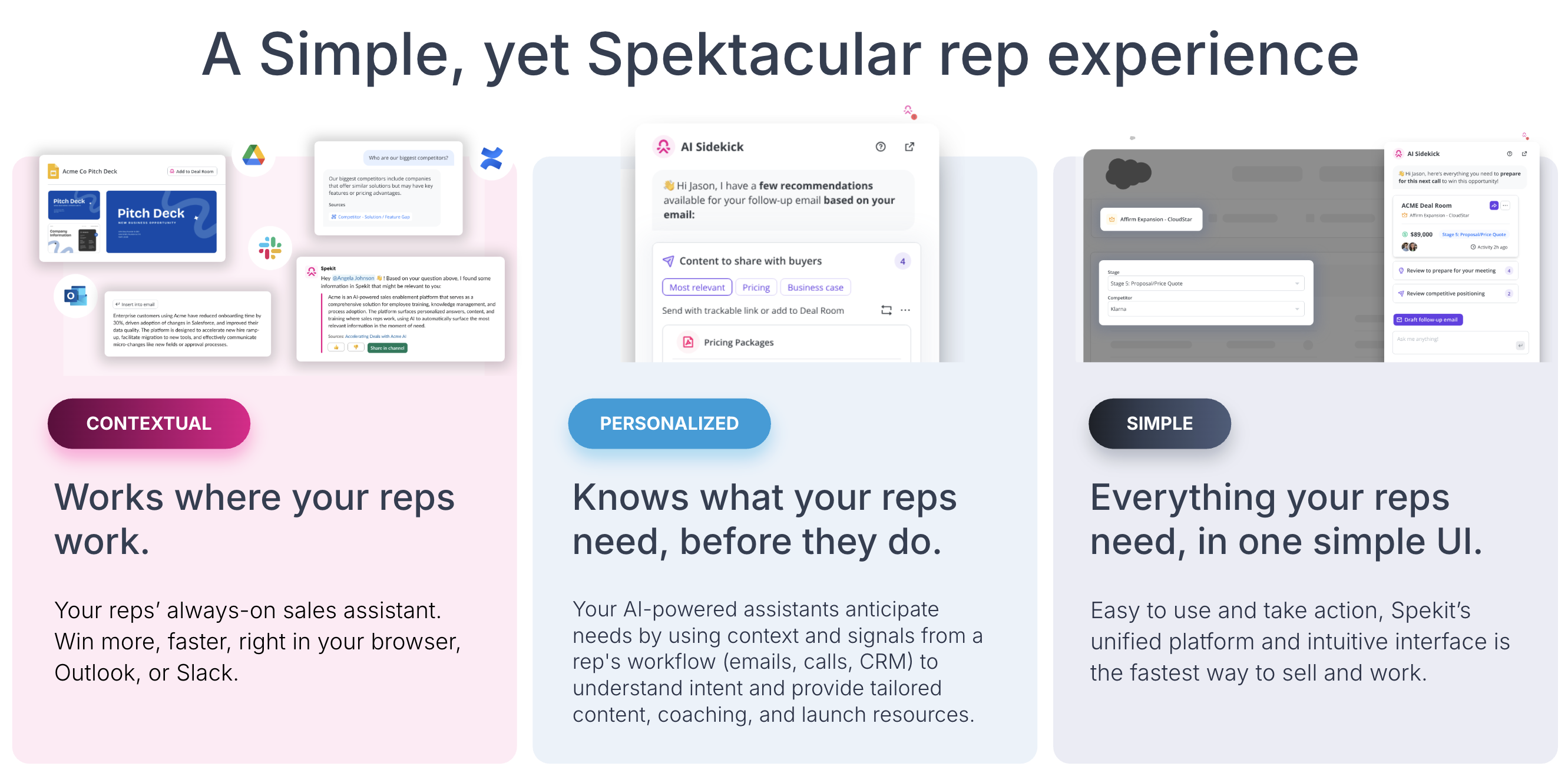
2. In-field definitions and tooltips.
Confused about what counts as “qualified”? Spekit surfaces that exact definition, right next to the field in Salesforce, so reps don’t guess or have to ask a manager.

3. Process-aligned playbooks, triggered by context.
You can turn frameworks like MEDDIC or BANT into step-by-step guides, then use AI to surface the right piece at the right time.
When a rep hits a new deal stage, they don’t get a document—they get live, contextual help.
4. Live updates across every channel.
The moment messaging or process changes, Spekit updates it everywhere—Slack, Salesforce, Gmail, Chrome—without asking reps to re-learn or re-download anything.
4. AI replaces searching with instant, in-context answers
Your rep needs a one-pager for a manufacturing CFO.
They open Slack, search the drive, ping a teammate, skim four versions…and the call’s already started.
This is what tab fatigue looks like and it kills momentum.
AI sales enablement tools read the room, deal stage, persona, conversation notes, and deliver what’s needed before the rep even clicks.
Spekit transforms content discovery into a proactive, Context × AI experience. AI Sidekick anticipates what reps need based on deal stage, persona, and CRM signals, serving tailored recommendations, content, or next steps without a single search.
1. Think Spotify for sales content: modular, searchable, and always ready to queue up the perfect resource.
Whether your reps are prepping for a call in Gmail, sending a proposal from Salesforce, or replying to a prospect in Slack, Spekit meets them where they are. Not the other way around.
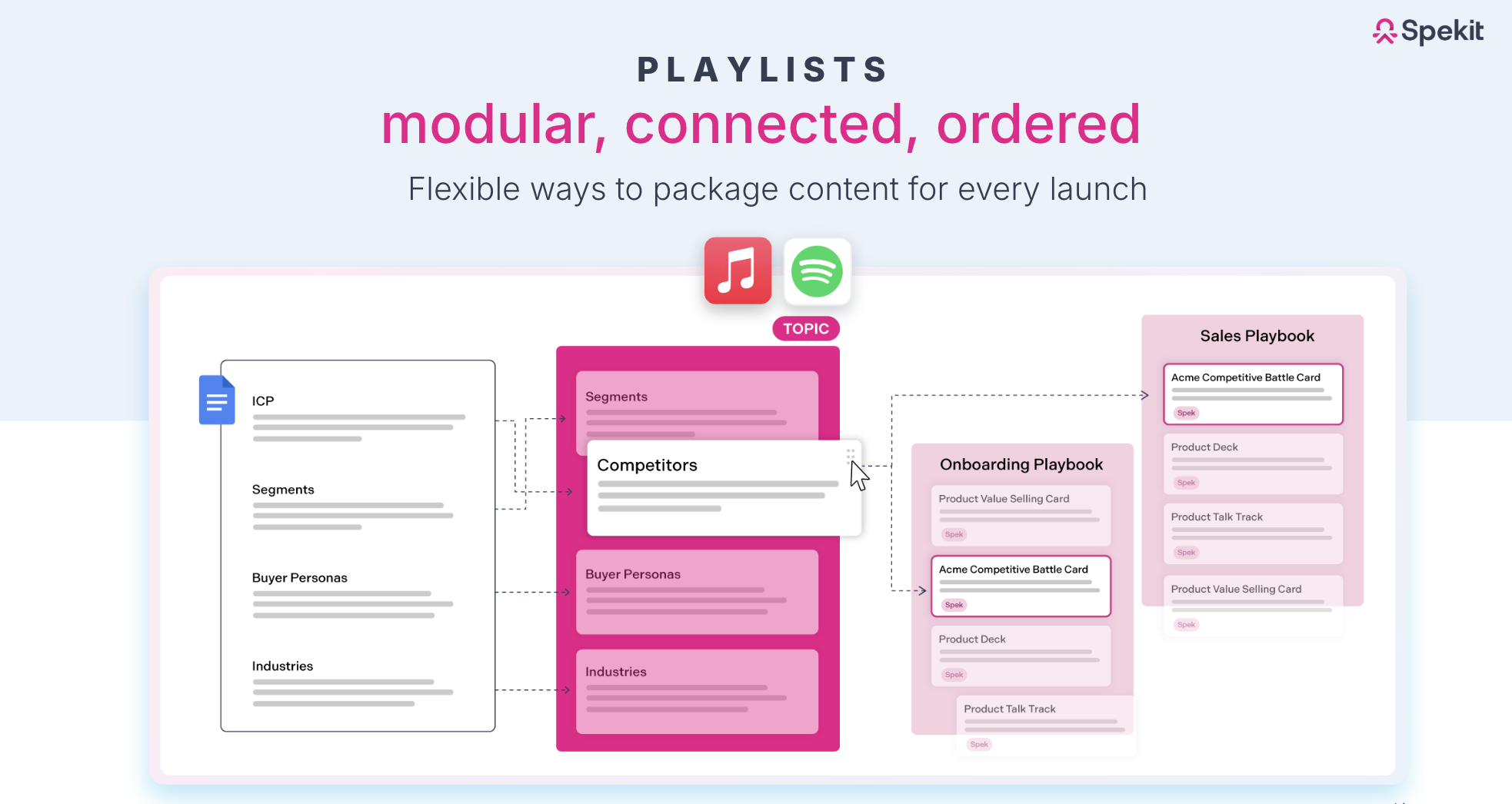
2. AI surfaces tailored content based on the rep’s tool, task, and context.
Call coming up? It recommends a case study, pitch deck, and talking points automatically. Need to respond to an objection in Outlook?
The right battle card appears without leaving your inbox.
Say a rep finishes a great discovery call. Now, the buyer wants examples of similar customer success stories.
The old way: The rep digs through Chorus to review the call, realizes they need a case study, opens a dozen tabs, pings Marketing in Slack, then waits.
The Spekit way: Spekit AI analyzes the call summary, identifies the intent, and immediately serves up a high-performing case study from a similar industry, ready to send.
5. AI scales coaching without adding headcount
Sales coaching works, but it doesn’t scale. Managers don’t have time to review every call, spot every gap, or deliver personalized feedback to every rep.
In a recent sales training survey we ran with JB Sales, 67% of reps said a lack of reinforcement after a session hurt their ability to apply what they learned. Another 18% said they were overwhelmed by too much information at once.
AI sales enablement tools change that by analyzing conversations at scale, spotting common breakdowns, and delivering bite-sized nudges that reinforce the right behavior, right when it’s needed.
For example, with Spekit, AI Sidekick identifies coaching moments by analyzing calls, CRM updates, and emails, then delivers personalized guidance in real time. Reps receive in-the-moment feedback and embedded Knowledge Checks directly in their tools, transforming coaching into an automated, scalable process.
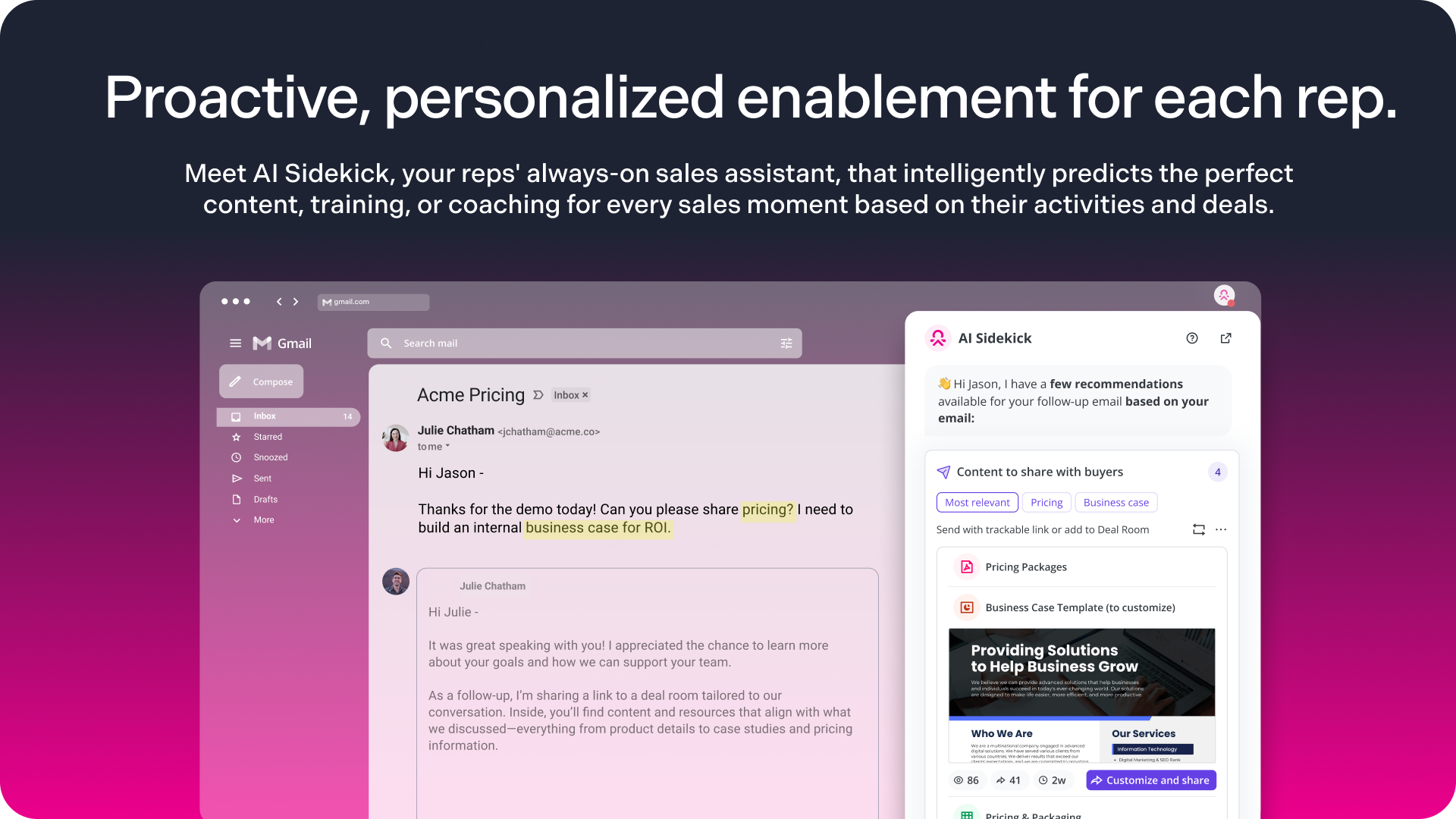
6. AI turns institutional knowledge into team-wide advantage
Your most valuable sales insights are often hiding in plain sight, tucked in Slack threads, buried in call recordings, or shared in passing during a team huddle. The problem is that they never make it into playbooks or formal training.
AI sales enablement tools helps you capture frontline knowledge as it’s happening and turn it into something every rep can use. What one person figures out mid-deal can now become a team wide asset, automatically.
With Spekit, every insight can become an asset. AI Sidekick turns Slack messages, call snippets, or field notes into ready-to-publish Speks or Deal Room resources, automatically formatted and synced across teams. The result: institutional knowledge that scales and stays current.
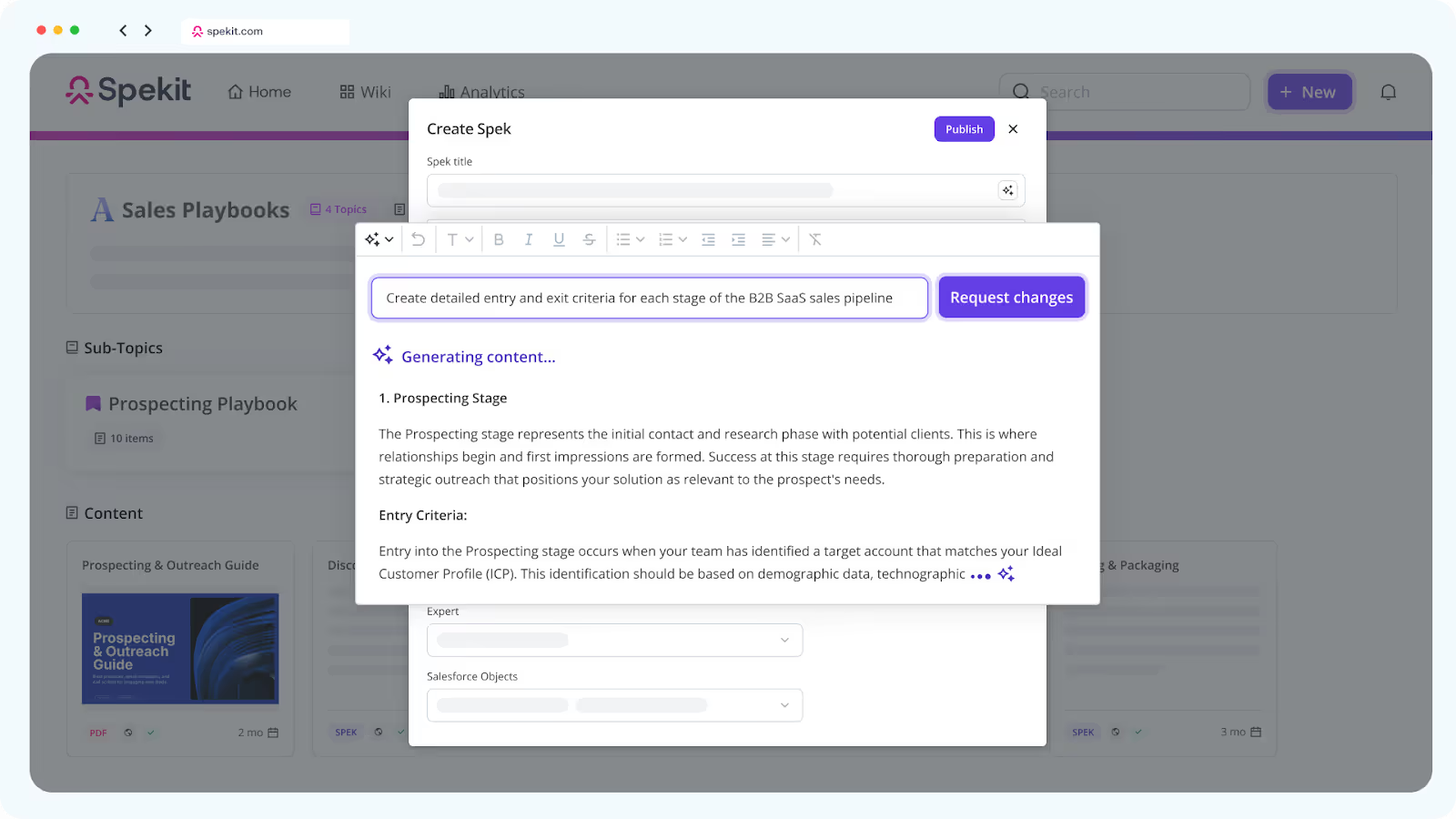
- Refine and scale fast: From that raw input, you can instantly clean up, format, and distribute the insight across your team. That one golden nugget? It’s now a searchable, clickable resource inside the tools reps use every day.
- Keep content current: As market conditions shift or new insights emerge, AI helps you quickly update shared knowledge so it stays current and useful.
What used to take a training session now takes a few clicks and when one rep figures something out, the whole team has access to it too.
3 AI sales enablement platforms to help you close more deals
There are now hundreds of sales enablement software out there that claim to use AI to improve sales outcomes and make sales enablement team’s life easier. Below are three we believe are actually getting it right.
1. Spekit: Modern, AI-powered enablement software
Best for: Spekit AI sales enablement platform unifies content management, enablement, and sales process automation to help revenue teams move faster and close deals quicker. Its AI Sidekick is the only Just-in-Time Sales Assistant™ that delivers personalized guidance, content, and recommendations right where reps work, from Salesforce to Gong to Gmail.
Reps forget what they learned and can’t find what they need. Spekit solves this by embedding bite-sized training, process guidance, and content recommendations into every app reps already use.
And that’s why real users LOVE us:


Key features:
- AI Sidekick: Contextual AI agents that anticipate rep needs, automate workflows, and deliver real-time enablement.
- Intelligent content management : Spekit's CMS uses AI to make sure your content stays organized, up-to-date, and distributed.
- Deal Rooms: Branded, trackable buyer hubs built directly in the flow of work, syncing instantly with updates and surfacing buyer engagement analytics tied to revenue.
- AI-powered content recommendations: Surfaces high-performing sales content (like decks or case studies) next to any call, email, or CRM update based on rep behavior and deal context.
- Revenue Insights: Ties content and Deal Room engagement directly to pipeline, influenced revenue, and closed-won opportunities.
- Governance Dashboard: Automates content oversight to flag outdated or low-adoption assets and maintain version control.
- Fastest Implementation: Minimal setup, instant integrations, and built-in change management tools make Spekit the quickest to launch and scale.
- Real-time updates + alerts: Push new content or process changes instantly, with in-app notifications and emails to make sure nothing gets missed.
Real-life success story: ZoomInfo used Spekit to embed enablement directly into reps’ workflows, tripling engagement with training content and unlocking millions in new sales pipeline.
“When we calculated the impact based on average sales price, we realized we had recovered millions of dollars in pipeline,” Luke Martin, Senior Manager of Revenue Enablement Infrastructure & Operations, says. “And the best part? We could directly attribute it back to our enablement efforts.” [Read the case study here.]
Integrations: Forget the hassle of managing a patchwork of integrations. With the Spekit Chrome Extension, you can instantly surface knowledge, training, and answers directly in the tools your reps already use from Salesforce to Gong, Outreach, Gmail, and more. And when you want even deeper functionality? Spekit offers native integrations and expanded capabilities that take the experience even further:
- CRM: Salesforce, HubSpot
- Conferencing and call intelligence: Gong, ZoomInfo
- Sales engagement: Outreach, Salesloft
- Email and communication: Outlook, Gmail, Slack
- Content repositories: Google Drive, SharePoint, Confluence
- Identity and access management: Ping One, Okta, Microsoft Azure, Salesforce, OneLogin

Pricing: Available upon request.
2. Gong
Best for: Enablement and Rev Ops leaders who want deep post-call analysis but have a separate solution for just-in-time enablement.

You can’t coach what you don’t hear. Gong analyzes calls to give leaders visibility into rep behavior and deal risks.
Key features:
- Conversation intelligence: Automatically records and transcribes sales calls, emails, and meetings, then analyzes them to identify trends, risks, and coaching moments.
- Concept tracking (not just keywords): Gong’s AI understands themes, questions, and objections, so you get insights on what’s really happening in the conversation.
- Custom AI models: Train Gong’s AI on your company’s terminology, products, and processes so the platform adapts to your exact sales motion.
- Coaching dashboards: Spot coaching opportunities across teams with call scoring, behavior trends, and side-by-side rep comparisons.
Integrations:
- CRM: Salesforce, HubSpot, Microsoft Dynamics
- Conferencing: Zoom, Microsoft Teams, Webex, GoToMeeting
- Telephony: Dialpad, RingCentral, Aircall, 8x8
- Sales engagement: Outreach, Salesloft
- Collaboration: Slack
Pricing: Custom; license-based with a platform fee that scales by team size.
3. Mindtickle
Best for: Organizations that need formal onboarding, certifications, and readiness tracking, especially in regulated or compliance-heavy industries.
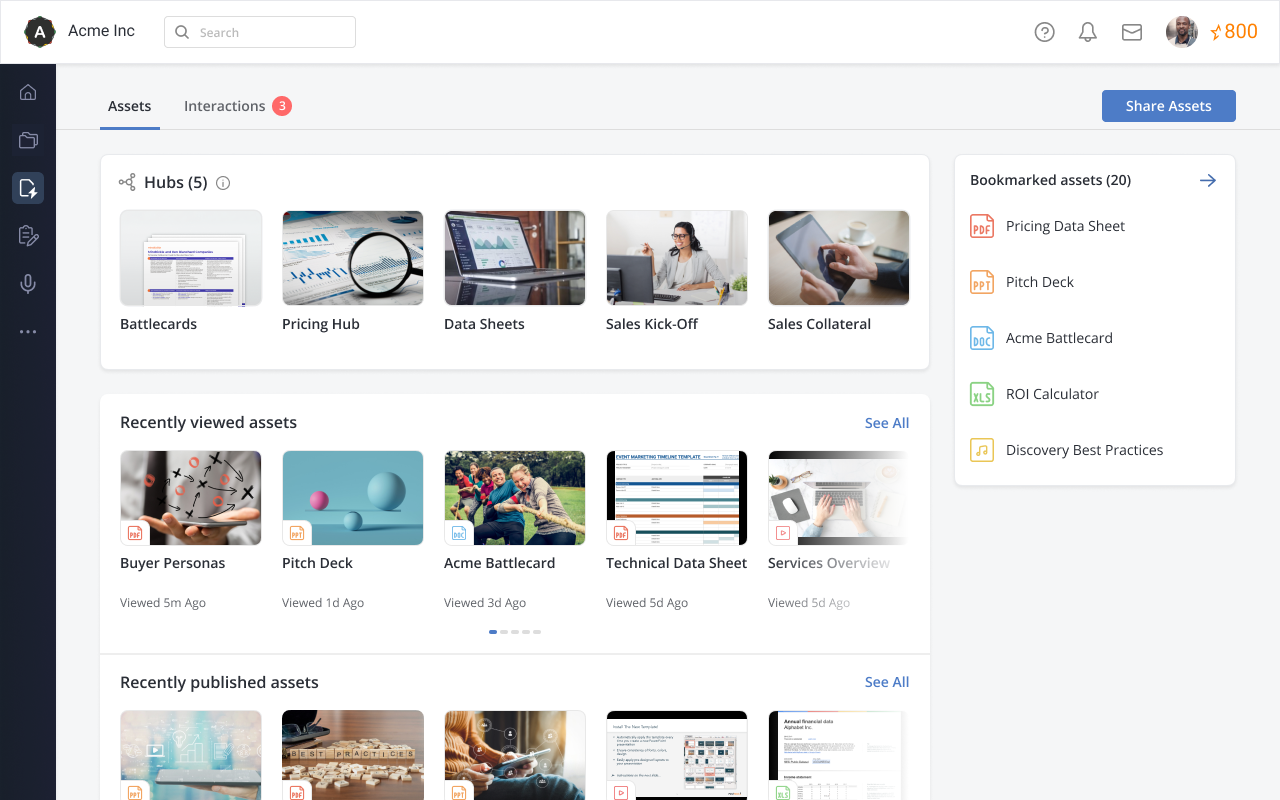
Key features:
- Structured onboarding programs: Build scalable learning paths with milestones, checkpoints, and deadlines across roles or regions.
- Certifications and skills assessments: Validate rep readiness with interactive certifications, role-playing exercises, and peer or manager evaluations.
- Video-based coaching and feedback: Let reps practice pitches, respond to prompts, and get scored feedback on delivery.
- Gamification and engagement tools: Boost rep participation with points, leaderboards, and progress tracking to keep training momentum high.
- Readiness analytics: Track who’s completed training, where they’re getting stuck, and how enablement affects performance at the team or individual level.
Integrations:
- CRM: Salesforce
- Collaboration: Slack, Microsoft Teams
- Video and conferencing: Zoom
- Content and storage: Google Drive, OneDrive
- Other: Workday, Seismic, plus API for custom integrations
Pricing: Custom; typically mid-to-enterprise range, depending on scale and features.
A 4-step evaluation grid to use before you reach out to an AI enablement software provider
This framework comes straight from Spekit CEO Melanie Fellay’s book Just-In-Time: The Future of Enablement in a World of AI.
Avoid the “shiny-object” trap. The one where flashy demos, slick UIs, and buzzwords distract you from the main goal: solving your actual enablement problems.
Before you take a single demo, map out what matters most. Here’s the simple evaluation grid Melanie recommends:
Next steps:
Have everyone on the team rate each solution (1–5) against your criteria, where 1 is “Doesn’t meet the requirement at all” and 5 is “Exceeds the requirement and adds significant value.” The results give you a clear, unbiased snapshot, so you’re not swayed by the flashiest feature set.
Once you’ve proven the value, buy-in becomes easier when it's time to scale.

